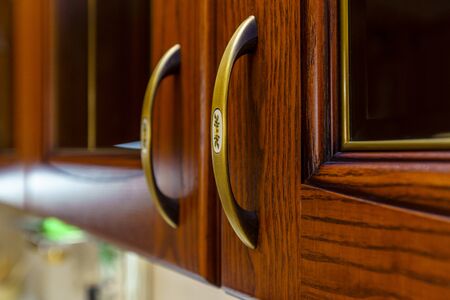Understanding the Needs of Indian Kitchens
Indian kitchens are truly the heart of every home, where generations come together to prepare meals rich in tradition and flavour. Unlike Western kitchens, Indian kitchens must cater to heavy-duty cooking involving frequent use of oil, spices, and high temperatures. The preparation of rotis, curries, biryanis, and an array of snacks demands robust kitchen hardware that can withstand daily wear and tear. In most Indian households, space optimisation is also a key concern—kitchens often need to accommodate large utensils, pressure cookers, masala boxes, and various gadgets in compact spaces. Moreover, traditional culinary practices such as grinding masalas or fermenting batter require specialised storage solutions and easy-to-clean surfaces. Understanding these unique needs is crucial when selecting kitchen hardware that is not only stylish but also practical for the modern Indian home.
Trendy Kitchen Hardware Options
When it comes to creating a modern Indian kitchen, the latest modular hardware options are a game changer. Indian families value both style and practicality, especially in urban homes where space is at a premium. Today’s kitchens are equipped with innovative fittings that not only look chic but also boost everyday efficiency. Here’s a quick overview of trendy kitchen hardware features popular in Indian households:
Popular Modular Kitchen Hardware
| Hardware Type | Main Benefits | Best For |
|---|---|---|
| Pull-Out Cabinets | Effortless access to utensils & groceries, maximizes corner spaces | L-shaped & parallel kitchens |
| Soft-Close Drawers | Reduces noise, prevents damage from slamming, smooth operation | Families with kids & elders |
| Space-Saving Racks | Keeps spices, jars & crockery organized, uses vertical storage | Compact city apartments |
Why These Features Suit Indian Homes?
With diverse cooking styles and frequent gatherings, Indian kitchens need robust yet elegant solutions. Pull-out cabinets are perfect for storing masalas and heavy utensils commonly used in desi cooking. Soft-close drawers minimize disturbance during early morning chai preparations or late-night snacks. Space-saving racks help organize everything from pressure cookers to tiffin boxes without cluttering countertops.
A Blend of Functionality and Style
The shift towards modular kitchen hardware reflects the aspiration of Indian homeowners to combine aesthetics with utility. Modern finishes like matte black or brushed steel blend beautifully with traditional wooden cabinets and vibrant wall tiles seen in many Indian kitchens. Choosing the right hardware ensures your kitchen remains both practical for daily use and impressive when guests arrive.

3. Practical Storage Solutions for Indian Spices & Utensils
Indian kitchens are renowned for their vibrant array of spices and unique cookware, from masalas to heavy-bottomed pressure cookers and multi-tiered tiffin boxes. To keep these essentials organised and easily accessible, modern kitchen hardware offers smart solutions tailored to Indian cooking habits. Innovative spice pull-out racks with adjustable sections can neatly display haldi, mirchi, jeera, and other masalas, making everyday tadka a breeze. Deep drawer organisers are perfect for storing large ladles, spatulas, and rolling pins (belan), ensuring they don’t clutter the countertop. Specialised corner units and carousel trays maximise space for storing pressure cookers or kadais, while compartmentalised tiffin box holders keep lunch carriers ready for busy mornings. These hardware options not only improve convenience but also add a sleek, contemporary touch to traditional kitchens, blending practicality with style for every Indian home.
Durability and Materials Suited for Indian Climates
When selecting kitchen hardware for Indian homes, durability is a top priority. The unique climate in many parts of India—including high humidity, monsoon seasons, and intense heat—means that materials must be chosen carefully to ensure long-lasting performance and style.
Why Material Matters in Indian Kitchens
Indian kitchens are known for frequent cooking, often involving spices, oils, and regular cleaning. This environment can be tough on hardware, making it important to choose materials that will not only withstand daily use but also resist corrosion and wear over time.
Popular Hardware Materials and Their Benefits
| Material | Main Features | Ideal For |
|---|---|---|
| Stainless Steel | Rust-resistant, easy to clean, strong | Drawers, handles, hinges in humid areas |
| Anodized Aluminium | Lightweight, corrosion-resistant, modern look | Sleek cabinet handles & open shelves |
| Zinc Alloy with Rust-resistant Coating | Durable, versatile designs, affordable | Budget-friendly yet stylish hardware options |
| PVC or ABS Plastic (High Quality) | Waterproof, easy maintenance, colourful options | Kitchens prone to spills or in coastal cities |
Choosing the Right Finish for Lasting Appeal
Apart from the core material, the finish also plays a crucial role. Popular choices include chrome plating, powder coating, and brushed finishes—all designed to resist stains and moisture. These finishes help maintain both the appearance and hygiene of your kitchen hardware even after years of use.
By focusing on durable materials and protective finishes specifically suited for Indian climates, homeowners can create kitchens that remain functional and beautiful—regardless of weather or cooking habits.
5. Customisation and Local Sourcing
When it comes to designing the perfect Indian kitchen, customisation plays a crucial role. Indian homes have diverse cooking styles, unique storage needs, and specific cultural preferences that off-the-shelf solutions often fail to address. Opting for custom-made kitchen fittings allows homeowners to design modular cabinets, pull-out shelves, trolleys, and organisers that perfectly match their lifestyle and space requirements. For example, you can get specially designed spice racks for masalas or deep drawers for storing heavy utensils like kadais and pressure cookers.
Another key advantage lies in sourcing hardware from reputable Indian brands. Local manufacturers understand the demands of Indian kitchens—be it handling high humidity levels or frequent oil spills—and use materials and finishes suitable for such environments. By choosing trusted Indian brands, you also ensure better after-sales service, easy availability of spare parts, and products built with local craftsmanship in mind.
Moreover, local sourcing is budget-friendly. You can find hardware options across various price points, making it easier to stick to your budget without compromising on quality or style. Many Indian suppliers even offer customisation at competitive prices, so you get a truly personalised kitchen experience that reflects your tastes and meets your practical needs.
Ultimately, embracing customisation and supporting homegrown brands empowers you to create a kitchen that’s not just functional but also celebrates Indian culture and traditions—right from the material selection to the finishing touches.
6. Tips for Maintaining Kitchen Hardware
Indian kitchens are vibrant spaces where spices, oils, and rich flavours come together daily. This environment can put your kitchen hardware to the test. To keep your cabinet handles, drawer pulls, and hinges looking stylish and functioning smoothly, follow these simple tips tailored for Indian homes.
Regular Cleaning is Key
With frequent cooking, dust and grease tend to settle on hardware surfaces. Wipe down handles and knobs weekly with a soft cloth dampened in a mild soapy solution. Avoid harsh chemicals that can tarnish finishes, especially on brass or stainless steel commonly found in Indian homes.
Protect Against Moisture
Humidity from boiling curries or making chai can affect hardware over time. Make sure to dry all hardware thoroughly after cleaning. For extra protection, consider applying a thin layer of clear wax or oil on metallic surfaces to prevent rusting and preserve shine.
Mind the Hinges and Moving Parts
Indian kitchens often see heavy usage of cabinets and drawers. Lubricate hinges and drawer slides every few months with light machine oil or silicone spray to keep them opening smoothly, even during busy festival preparations or family gatherings.
Avoid Abrasive Tools
Skip scrubbing pads or steel wool when cleaning kitchen hardware. Use only soft sponges or microfiber cloths to prevent scratching decorative finishes like matte black, bronze, or gold which are popular in contemporary Indian kitchens.
Immediate Attention to Spills
If masala, turmeric, or other strong-coloured ingredients spill on your hardware, wipe them off immediately. These can leave stains if left unattended and may require stronger cleaning agents later, risking damage to the finish.
Inspect Regularly for Loose Screws
The climate in India can cause screws to loosen due to expansion and contraction. Check all handles and knobs monthly and tighten any loose fixtures promptly to avoid accidental falls or misalignment.
Embrace Natural Cleaners
Lemon juice diluted with water works well for removing fingerprints from stainless steel without leaving residue. Vinegar (diluted) is another handy option but should be used sparingly on metals to avoid corrosion over time.
By following these easy maintenance routines suited for Indian kitchens, you can ensure your kitchen hardware remains as functional and stylish as the day it was installed—ready to support every home-cooked meal and family celebration for years to come.


